Case Study on Taxation Law 2022
VerifiedAdded on 2022/10/18
|9
|2328
|11
AI Summary
Contribute Materials
Your contribution can guide someone’s learning journey. Share your
documents today.
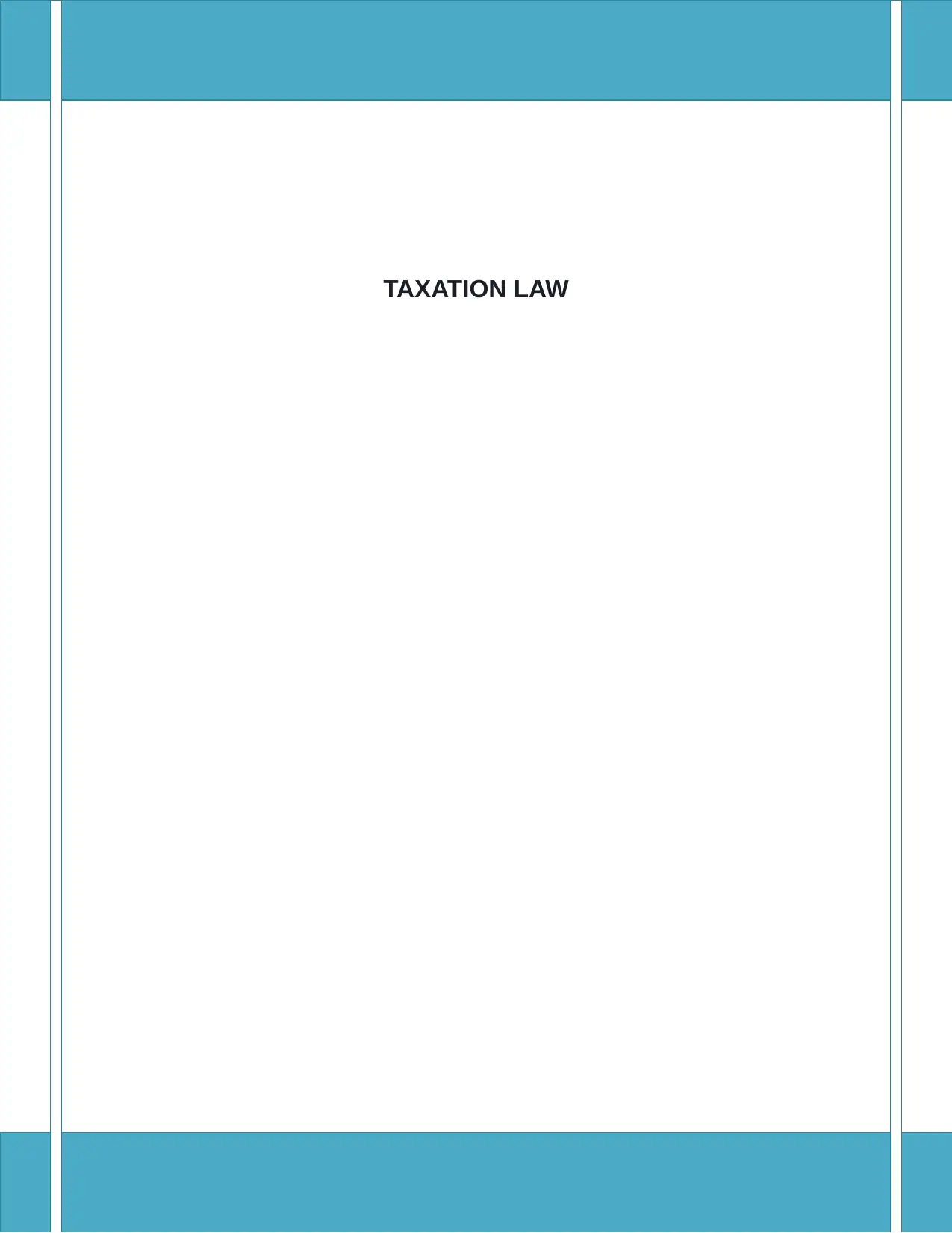
TAXATION LAW
Secure Best Marks with AI Grader
Need help grading? Try our AI Grader for instant feedback on your assignments.
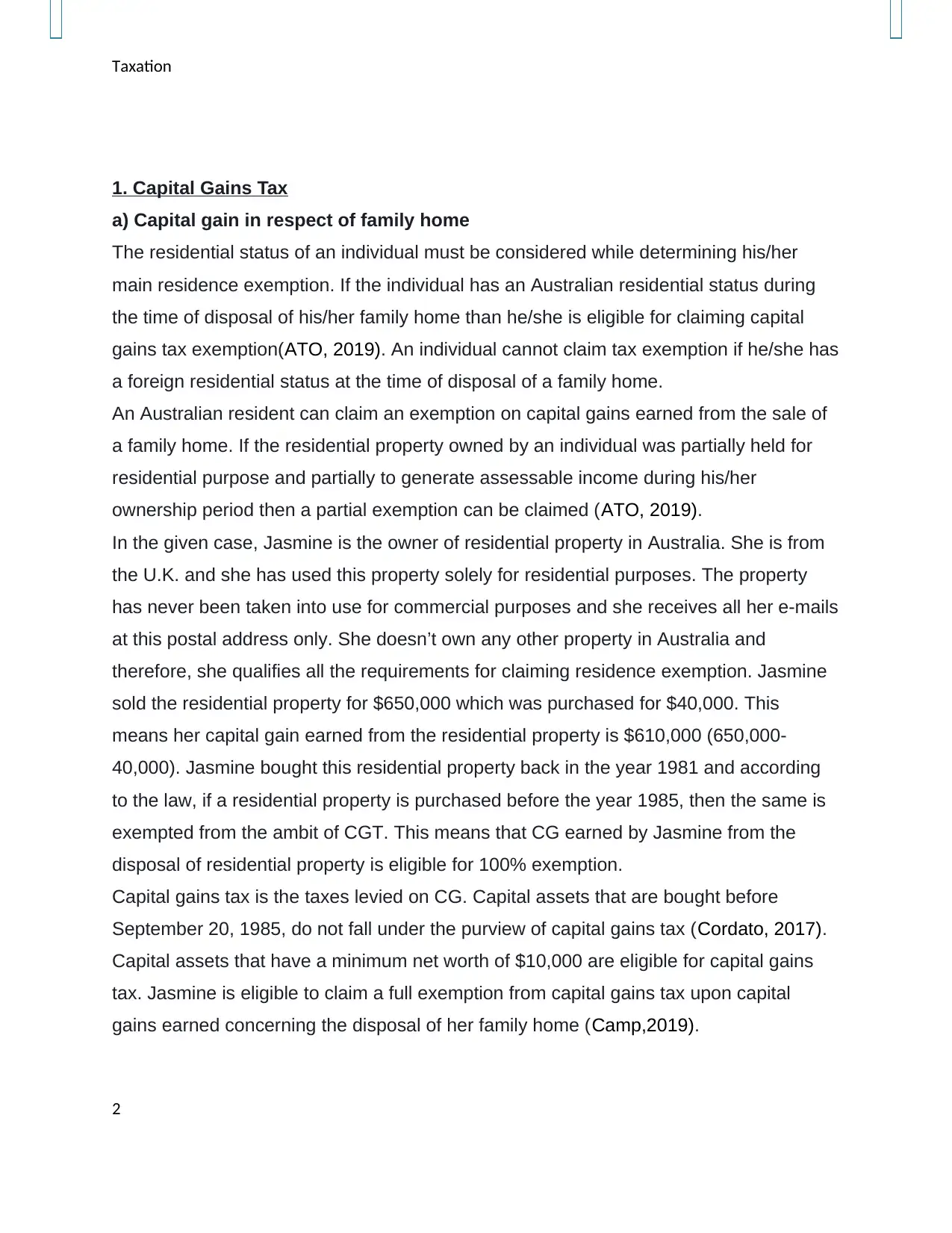
Taxation
1. Capital Gains Tax
a) Capital gain in respect of family home
The residential status of an individual must be considered while determining his/her
main residence exemption. If the individual has an Australian residential status during
the time of disposal of his/her family home than he/she is eligible for claiming capital
gains tax exemption(ATO, 2019). An individual cannot claim tax exemption if he/she has
a foreign residential status at the time of disposal of a family home.
An Australian resident can claim an exemption on capital gains earned from the sale of
a family home. If the residential property owned by an individual was partially held for
residential purpose and partially to generate assessable income during his/her
ownership period then a partial exemption can be claimed (ATO, 2019).
In the given case, Jasmine is the owner of residential property in Australia. She is from
the U.K. and she has used this property solely for residential purposes. The property
has never been taken into use for commercial purposes and she receives all her e-mails
at this postal address only. She doesn’t own any other property in Australia and
therefore, she qualifies all the requirements for claiming residence exemption. Jasmine
sold the residential property for $650,000 which was purchased for $40,000. This
means her capital gain earned from the residential property is $610,000 (650,000-
40,000). Jasmine bought this residential property back in the year 1981 and according
to the law, if a residential property is purchased before the year 1985, then the same is
exempted from the ambit of CGT. This means that CG earned by Jasmine from the
disposal of residential property is eligible for 100% exemption.
Capital gains tax is the taxes levied on CG. Capital assets that are bought before
September 20, 1985, do not fall under the purview of capital gains tax (Cordato, 2017).
Capital assets that have a minimum net worth of $10,000 are eligible for capital gains
tax. Jasmine is eligible to claim a full exemption from capital gains tax upon capital
gains earned concerning the disposal of her family home (Camp,2019).
2
1. Capital Gains Tax
a) Capital gain in respect of family home
The residential status of an individual must be considered while determining his/her
main residence exemption. If the individual has an Australian residential status during
the time of disposal of his/her family home than he/she is eligible for claiming capital
gains tax exemption(ATO, 2019). An individual cannot claim tax exemption if he/she has
a foreign residential status at the time of disposal of a family home.
An Australian resident can claim an exemption on capital gains earned from the sale of
a family home. If the residential property owned by an individual was partially held for
residential purpose and partially to generate assessable income during his/her
ownership period then a partial exemption can be claimed (ATO, 2019).
In the given case, Jasmine is the owner of residential property in Australia. She is from
the U.K. and she has used this property solely for residential purposes. The property
has never been taken into use for commercial purposes and she receives all her e-mails
at this postal address only. She doesn’t own any other property in Australia and
therefore, she qualifies all the requirements for claiming residence exemption. Jasmine
sold the residential property for $650,000 which was purchased for $40,000. This
means her capital gain earned from the residential property is $610,000 (650,000-
40,000). Jasmine bought this residential property back in the year 1981 and according
to the law, if a residential property is purchased before the year 1985, then the same is
exempted from the ambit of CGT. This means that CG earned by Jasmine from the
disposal of residential property is eligible for 100% exemption.
Capital gains tax is the taxes levied on CG. Capital assets that are bought before
September 20, 1985, do not fall under the purview of capital gains tax (Cordato, 2017).
Capital assets that have a minimum net worth of $10,000 are eligible for capital gains
tax. Jasmine is eligible to claim a full exemption from capital gains tax upon capital
gains earned concerning the disposal of her family home (Camp,2019).
2
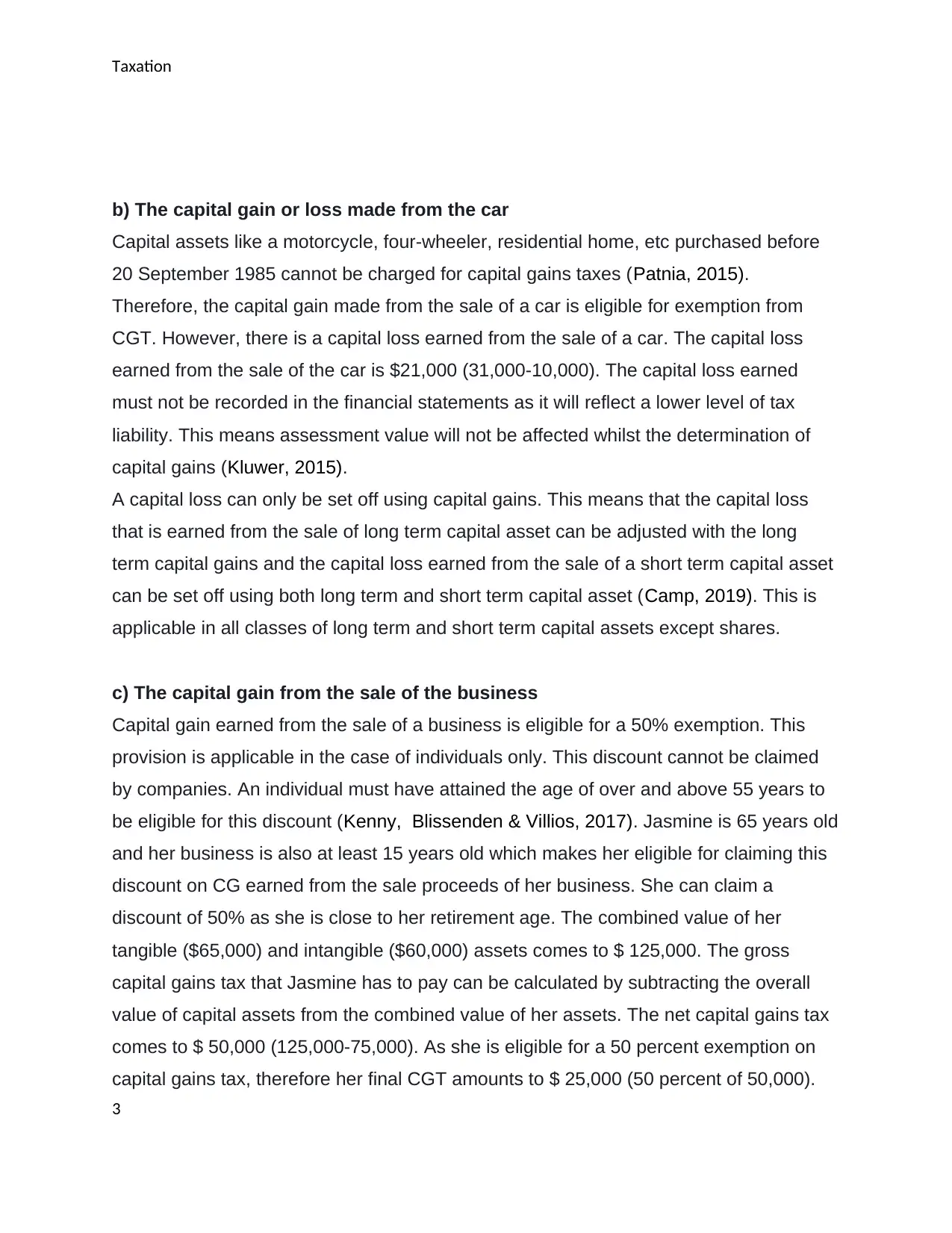
Taxation
b) The capital gain or loss made from the car
Capital assets like a motorcycle, four-wheeler, residential home, etc purchased before
20 September 1985 cannot be charged for capital gains taxes (Patnia, 2015).
Therefore, the capital gain made from the sale of a car is eligible for exemption from
CGT. However, there is a capital loss earned from the sale of a car. The capital loss
earned from the sale of the car is $21,000 (31,000-10,000). The capital loss earned
must not be recorded in the financial statements as it will reflect a lower level of tax
liability. This means assessment value will not be affected whilst the determination of
capital gains (Kluwer, 2015).
A capital loss can only be set off using capital gains. This means that the capital loss
that is earned from the sale of long term capital asset can be adjusted with the long
term capital gains and the capital loss earned from the sale of a short term capital asset
can be set off using both long term and short term capital asset (Camp, 2019). This is
applicable in all classes of long term and short term capital assets except shares.
c) The capital gain from the sale of the business
Capital gain earned from the sale of a business is eligible for a 50% exemption. This
provision is applicable in the case of individuals only. This discount cannot be claimed
by companies. An individual must have attained the age of over and above 55 years to
be eligible for this discount (Kenny, Blissenden & Villios, 2017). Jasmine is 65 years old
and her business is also at least 15 years old which makes her eligible for claiming this
discount on CG earned from the sale proceeds of her business. She can claim a
discount of 50% as she is close to her retirement age. The combined value of her
tangible ($65,000) and intangible ($60,000) assets comes to $ 125,000. The gross
capital gains tax that Jasmine has to pay can be calculated by subtracting the overall
value of capital assets from the combined value of her assets. The net capital gains tax
comes to $ 50,000 (125,000-75,000). As she is eligible for a 50 percent exemption on
capital gains tax, therefore her final CGT amounts to $ 25,000 (50 percent of 50,000).
3
b) The capital gain or loss made from the car
Capital assets like a motorcycle, four-wheeler, residential home, etc purchased before
20 September 1985 cannot be charged for capital gains taxes (Patnia, 2015).
Therefore, the capital gain made from the sale of a car is eligible for exemption from
CGT. However, there is a capital loss earned from the sale of a car. The capital loss
earned from the sale of the car is $21,000 (31,000-10,000). The capital loss earned
must not be recorded in the financial statements as it will reflect a lower level of tax
liability. This means assessment value will not be affected whilst the determination of
capital gains (Kluwer, 2015).
A capital loss can only be set off using capital gains. This means that the capital loss
that is earned from the sale of long term capital asset can be adjusted with the long
term capital gains and the capital loss earned from the sale of a short term capital asset
can be set off using both long term and short term capital asset (Camp, 2019). This is
applicable in all classes of long term and short term capital assets except shares.
c) The capital gain from the sale of the business
Capital gain earned from the sale of a business is eligible for a 50% exemption. This
provision is applicable in the case of individuals only. This discount cannot be claimed
by companies. An individual must have attained the age of over and above 55 years to
be eligible for this discount (Kenny, Blissenden & Villios, 2017). Jasmine is 65 years old
and her business is also at least 15 years old which makes her eligible for claiming this
discount on CG earned from the sale proceeds of her business. She can claim a
discount of 50% as she is close to her retirement age. The combined value of her
tangible ($65,000) and intangible ($60,000) assets comes to $ 125,000. The gross
capital gains tax that Jasmine has to pay can be calculated by subtracting the overall
value of capital assets from the combined value of her assets. The net capital gains tax
comes to $ 50,000 (125,000-75,000). As she is eligible for a 50 percent exemption on
capital gains tax, therefore her final CGT amounts to $ 25,000 (50 percent of 50,000).
3
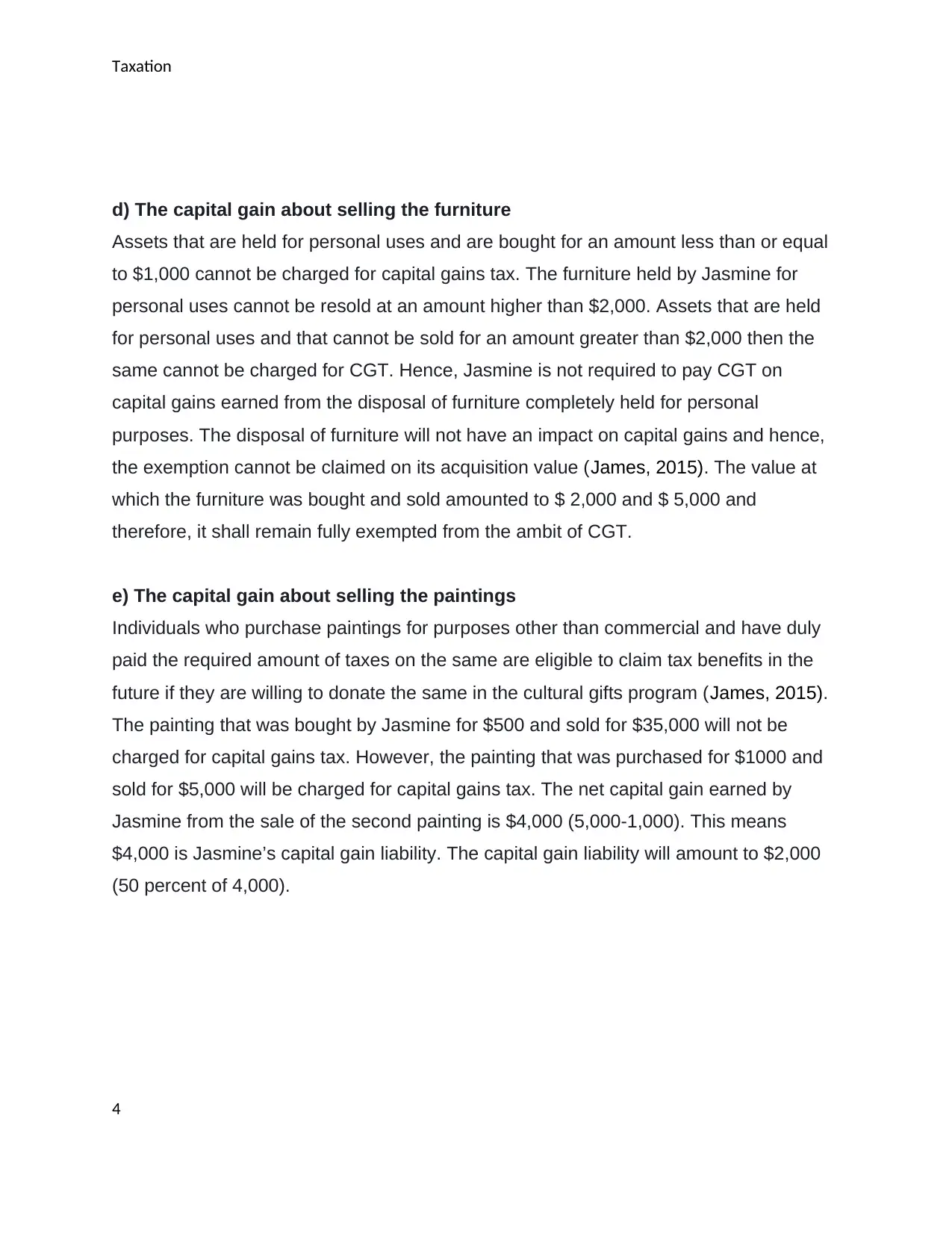
Taxation
d) The capital gain about selling the furniture
Assets that are held for personal uses and are bought for an amount less than or equal
to $1,000 cannot be charged for capital gains tax. The furniture held by Jasmine for
personal uses cannot be resold at an amount higher than $2,000. Assets that are held
for personal uses and that cannot be sold for an amount greater than $2,000 then the
same cannot be charged for CGT. Hence, Jasmine is not required to pay CGT on
capital gains earned from the disposal of furniture completely held for personal
purposes. The disposal of furniture will not have an impact on capital gains and hence,
the exemption cannot be claimed on its acquisition value (James, 2015). The value at
which the furniture was bought and sold amounted to $ 2,000 and $ 5,000 and
therefore, it shall remain fully exempted from the ambit of CGT.
e) The capital gain about selling the paintings
Individuals who purchase paintings for purposes other than commercial and have duly
paid the required amount of taxes on the same are eligible to claim tax benefits in the
future if they are willing to donate the same in the cultural gifts program (James, 2015).
The painting that was bought by Jasmine for $500 and sold for $35,000 will not be
charged for capital gains tax. However, the painting that was purchased for $1000 and
sold for $5,000 will be charged for capital gains tax. The net capital gain earned by
Jasmine from the sale of the second painting is $4,000 (5,000-1,000). This means
$4,000 is Jasmine’s capital gain liability. The capital gain liability will amount to $2,000
(50 percent of 4,000).
4
d) The capital gain about selling the furniture
Assets that are held for personal uses and are bought for an amount less than or equal
to $1,000 cannot be charged for capital gains tax. The furniture held by Jasmine for
personal uses cannot be resold at an amount higher than $2,000. Assets that are held
for personal uses and that cannot be sold for an amount greater than $2,000 then the
same cannot be charged for CGT. Hence, Jasmine is not required to pay CGT on
capital gains earned from the disposal of furniture completely held for personal
purposes. The disposal of furniture will not have an impact on capital gains and hence,
the exemption cannot be claimed on its acquisition value (James, 2015). The value at
which the furniture was bought and sold amounted to $ 2,000 and $ 5,000 and
therefore, it shall remain fully exempted from the ambit of CGT.
e) The capital gain about selling the paintings
Individuals who purchase paintings for purposes other than commercial and have duly
paid the required amount of taxes on the same are eligible to claim tax benefits in the
future if they are willing to donate the same in the cultural gifts program (James, 2015).
The painting that was bought by Jasmine for $500 and sold for $35,000 will not be
charged for capital gains tax. However, the painting that was purchased for $1000 and
sold for $5,000 will be charged for capital gains tax. The net capital gain earned by
Jasmine from the sale of the second painting is $4,000 (5,000-1,000). This means
$4,000 is Jasmine’s capital gain liability. The capital gain liability will amount to $2,000
(50 percent of 4,000).
4
Secure Best Marks with AI Grader
Need help grading? Try our AI Grader for instant feedback on your assignments.
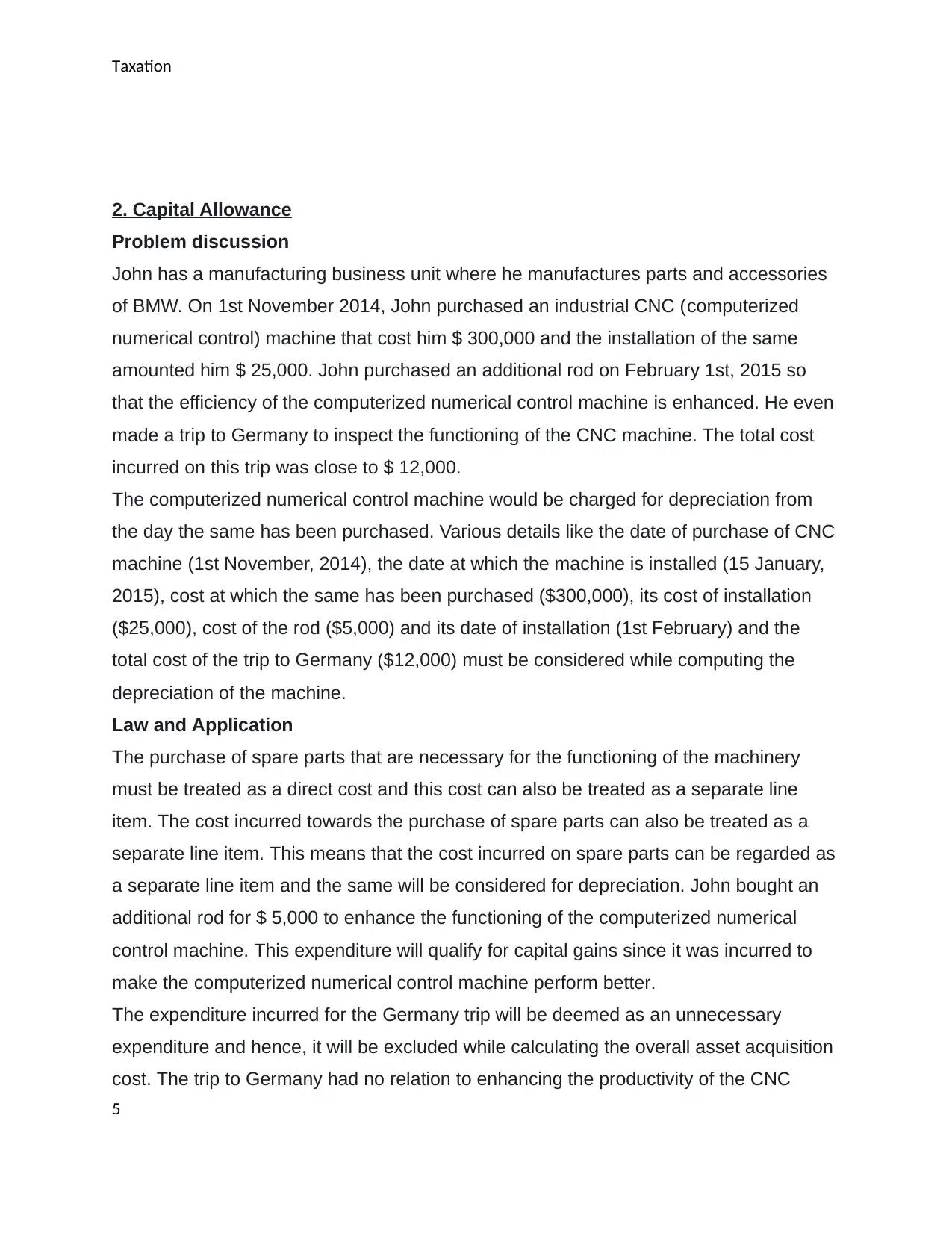
Taxation
2. Capital Allowance
Problem discussion
John has a manufacturing business unit where he manufactures parts and accessories
of BMW. On 1st November 2014, John purchased an industrial CNC (computerized
numerical control) machine that cost him $ 300,000 and the installation of the same
amounted him $ 25,000. John purchased an additional rod on February 1st, 2015 so
that the efficiency of the computerized numerical control machine is enhanced. He even
made a trip to Germany to inspect the functioning of the CNC machine. The total cost
incurred on this trip was close to $ 12,000.
The computerized numerical control machine would be charged for depreciation from
the day the same has been purchased. Various details like the date of purchase of CNC
machine (1st November, 2014), the date at which the machine is installed (15 January,
2015), cost at which the same has been purchased ($300,000), its cost of installation
($25,000), cost of the rod ($5,000) and its date of installation (1st February) and the
total cost of the trip to Germany ($12,000) must be considered while computing the
depreciation of the machine.
Law and Application
The purchase of spare parts that are necessary for the functioning of the machinery
must be treated as a direct cost and this cost can also be treated as a separate line
item. The cost incurred towards the purchase of spare parts can also be treated as a
separate line item. This means that the cost incurred on spare parts can be regarded as
a separate line item and the same will be considered for depreciation. John bought an
additional rod for $ 5,000 to enhance the functioning of the computerized numerical
control machine. This expenditure will qualify for capital gains since it was incurred to
make the computerized numerical control machine perform better.
The expenditure incurred for the Germany trip will be deemed as an unnecessary
expenditure and hence, it will be excluded while calculating the overall asset acquisition
cost. The trip to Germany had no relation to enhancing the productivity of the CNC
5
2. Capital Allowance
Problem discussion
John has a manufacturing business unit where he manufactures parts and accessories
of BMW. On 1st November 2014, John purchased an industrial CNC (computerized
numerical control) machine that cost him $ 300,000 and the installation of the same
amounted him $ 25,000. John purchased an additional rod on February 1st, 2015 so
that the efficiency of the computerized numerical control machine is enhanced. He even
made a trip to Germany to inspect the functioning of the CNC machine. The total cost
incurred on this trip was close to $ 12,000.
The computerized numerical control machine would be charged for depreciation from
the day the same has been purchased. Various details like the date of purchase of CNC
machine (1st November, 2014), the date at which the machine is installed (15 January,
2015), cost at which the same has been purchased ($300,000), its cost of installation
($25,000), cost of the rod ($5,000) and its date of installation (1st February) and the
total cost of the trip to Germany ($12,000) must be considered while computing the
depreciation of the machine.
Law and Application
The purchase of spare parts that are necessary for the functioning of the machinery
must be treated as a direct cost and this cost can also be treated as a separate line
item. The cost incurred towards the purchase of spare parts can also be treated as a
separate line item. This means that the cost incurred on spare parts can be regarded as
a separate line item and the same will be considered for depreciation. John bought an
additional rod for $ 5,000 to enhance the functioning of the computerized numerical
control machine. This expenditure will qualify for capital gains since it was incurred to
make the computerized numerical control machine perform better.
The expenditure incurred for the Germany trip will be deemed as an unnecessary
expenditure and hence, it will be excluded while calculating the overall asset acquisition
cost. The trip to Germany had no relation to enhancing the productivity of the CNC
5
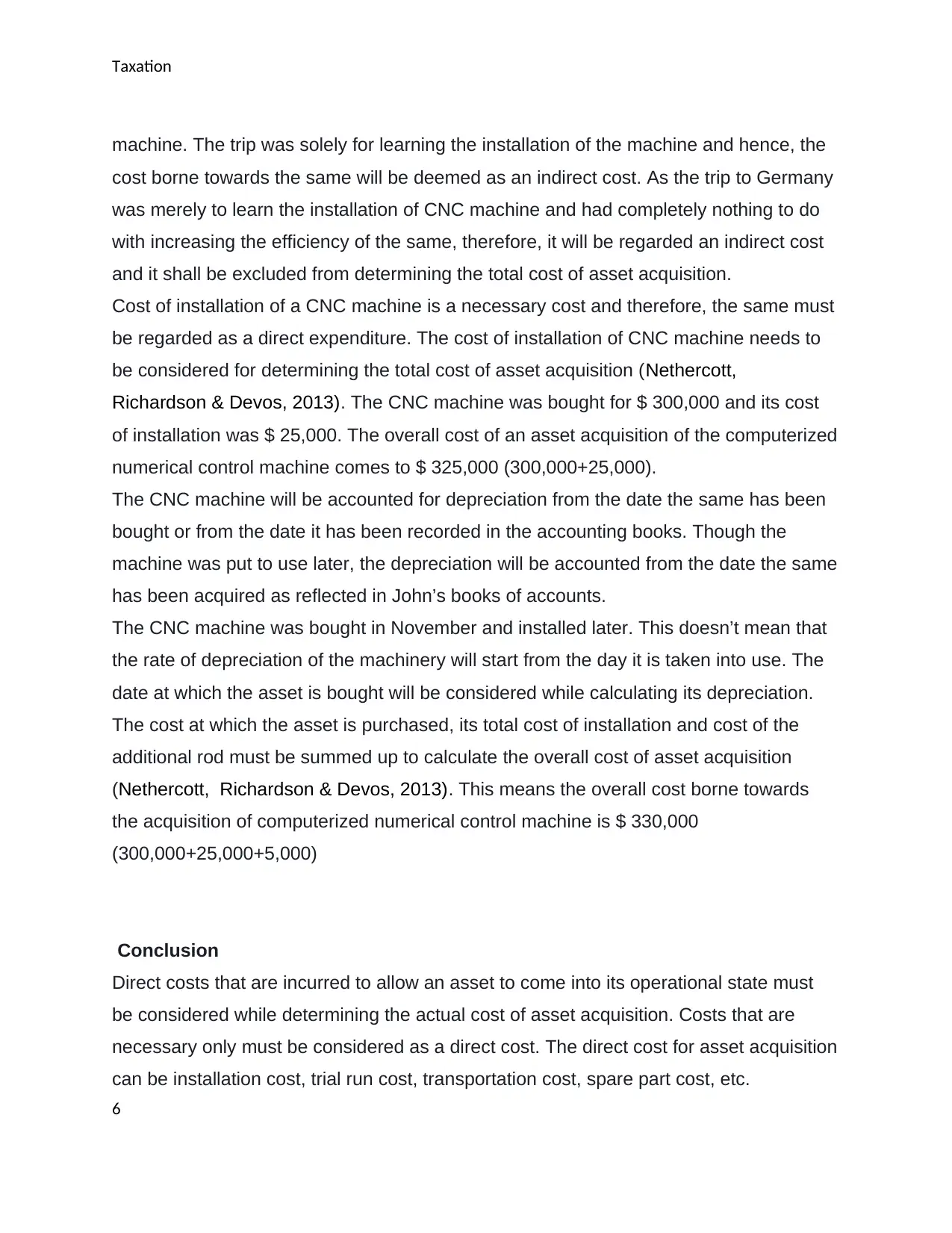
Taxation
machine. The trip was solely for learning the installation of the machine and hence, the
cost borne towards the same will be deemed as an indirect cost. As the trip to Germany
was merely to learn the installation of CNC machine and had completely nothing to do
with increasing the efficiency of the same, therefore, it will be regarded an indirect cost
and it shall be excluded from determining the total cost of asset acquisition.
Cost of installation of a CNC machine is a necessary cost and therefore, the same must
be regarded as a direct expenditure. The cost of installation of CNC machine needs to
be considered for determining the total cost of asset acquisition (Nethercott,
Richardson & Devos, 2013). The CNC machine was bought for $ 300,000 and its cost
of installation was $ 25,000. The overall cost of an asset acquisition of the computerized
numerical control machine comes to $ 325,000 (300,000+25,000).
The CNC machine will be accounted for depreciation from the date the same has been
bought or from the date it has been recorded in the accounting books. Though the
machine was put to use later, the depreciation will be accounted from the date the same
has been acquired as reflected in John’s books of accounts.
The CNC machine was bought in November and installed later. This doesn’t mean that
the rate of depreciation of the machinery will start from the day it is taken into use. The
date at which the asset is bought will be considered while calculating its depreciation.
The cost at which the asset is purchased, its total cost of installation and cost of the
additional rod must be summed up to calculate the overall cost of asset acquisition
(Nethercott, Richardson & Devos, 2013). This means the overall cost borne towards
the acquisition of computerized numerical control machine is $ 330,000
(300,000+25,000+5,000)
Conclusion
Direct costs that are incurred to allow an asset to come into its operational state must
be considered while determining the actual cost of asset acquisition. Costs that are
necessary only must be considered as a direct cost. The direct cost for asset acquisition
can be installation cost, trial run cost, transportation cost, spare part cost, etc.
6
machine. The trip was solely for learning the installation of the machine and hence, the
cost borne towards the same will be deemed as an indirect cost. As the trip to Germany
was merely to learn the installation of CNC machine and had completely nothing to do
with increasing the efficiency of the same, therefore, it will be regarded an indirect cost
and it shall be excluded from determining the total cost of asset acquisition.
Cost of installation of a CNC machine is a necessary cost and therefore, the same must
be regarded as a direct expenditure. The cost of installation of CNC machine needs to
be considered for determining the total cost of asset acquisition (Nethercott,
Richardson & Devos, 2013). The CNC machine was bought for $ 300,000 and its cost
of installation was $ 25,000. The overall cost of an asset acquisition of the computerized
numerical control machine comes to $ 325,000 (300,000+25,000).
The CNC machine will be accounted for depreciation from the date the same has been
bought or from the date it has been recorded in the accounting books. Though the
machine was put to use later, the depreciation will be accounted from the date the same
has been acquired as reflected in John’s books of accounts.
The CNC machine was bought in November and installed later. This doesn’t mean that
the rate of depreciation of the machinery will start from the day it is taken into use. The
date at which the asset is bought will be considered while calculating its depreciation.
The cost at which the asset is purchased, its total cost of installation and cost of the
additional rod must be summed up to calculate the overall cost of asset acquisition
(Nethercott, Richardson & Devos, 2013). This means the overall cost borne towards
the acquisition of computerized numerical control machine is $ 330,000
(300,000+25,000+5,000)
Conclusion
Direct costs that are incurred to allow an asset to come into its operational state must
be considered while determining the actual cost of asset acquisition. Costs that are
necessary only must be considered as a direct cost. The direct cost for asset acquisition
can be installation cost, trial run cost, transportation cost, spare part cost, etc.
6

Taxation
Depreciation is to be charged on an asset from the date the machinery is purchased
and not from the date the machinery has been installed or taken into use. The efficiency
of a machine keeps deteriorating day by day irrespective of the fact if the same is
installed or not. Hence, the depreciation on machinery must always be calculated from
the date it has been acquired irrespective of when the same is installed.
7
Depreciation is to be charged on an asset from the date the machinery is purchased
and not from the date the machinery has been installed or taken into use. The efficiency
of a machine keeps deteriorating day by day irrespective of the fact if the same is
installed or not. Hence, the depreciation on machinery must always be calculated from
the date it has been acquired irrespective of when the same is installed.
7
Paraphrase This Document
Need a fresh take? Get an instant paraphrase of this document with our AI Paraphraser
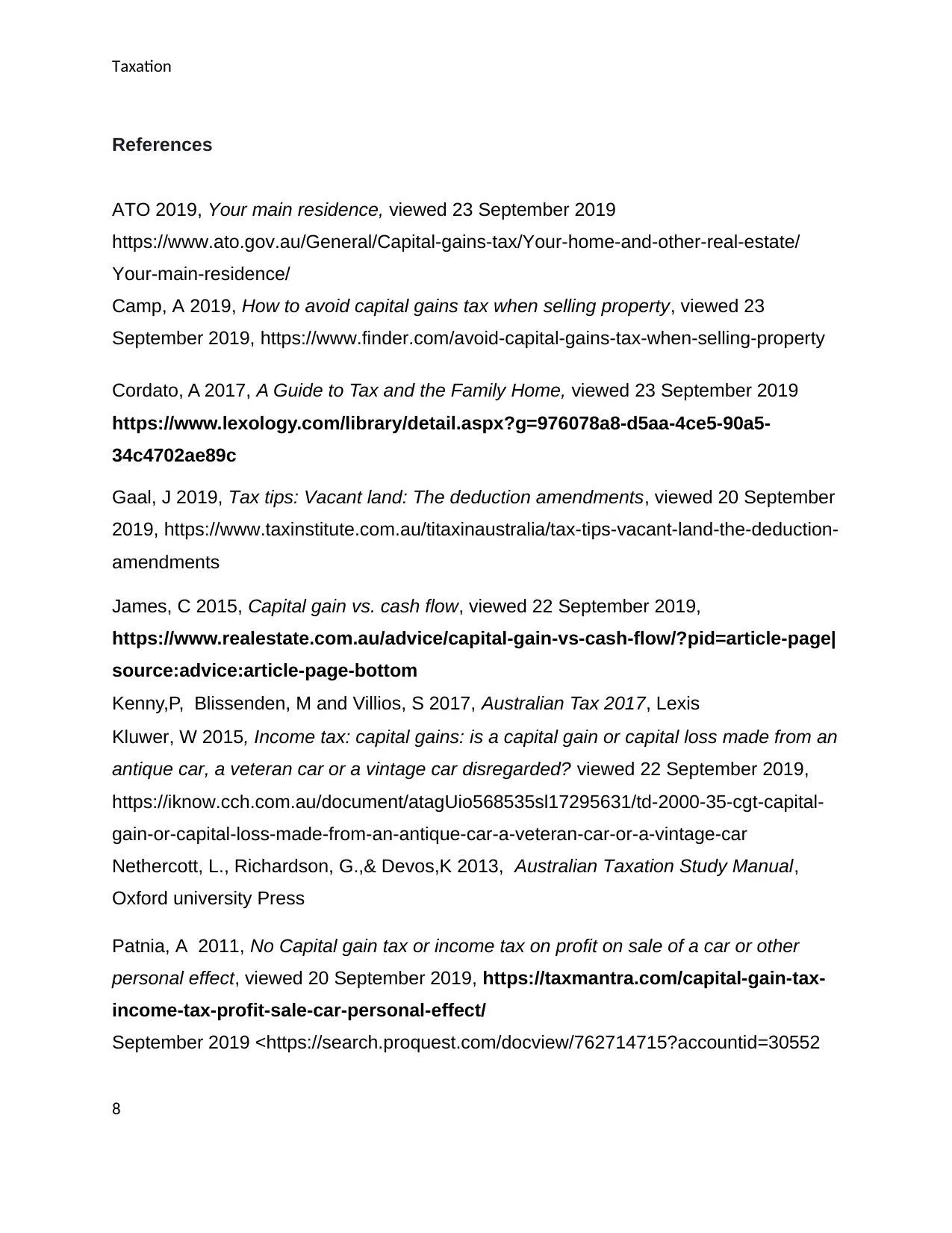
Taxation
References
ATO 2019, Your main residence, viewed 23 September 2019
https://www.ato.gov.au/General/Capital-gains-tax/Your-home-and-other-real-estate/
Your-main-residence/
Camp, A 2019, How to avoid capital gains tax when selling property, viewed 23
September 2019, https://www.finder.com/avoid-capital-gains-tax-when-selling-property
Cordato, A 2017, A Guide to Tax and the Family Home, viewed 23 September 2019
https://www.lexology.com/library/detail.aspx?g=976078a8-d5aa-4ce5-90a5-
34c4702ae89c
Gaal, J 2019, Tax tips: Vacant land: The deduction amendments, viewed 20 September
2019, https://www.taxinstitute.com.au/titaxinaustralia/tax-tips-vacant-land-the-deduction-
amendments
James, C 2015, Capital gain vs. cash flow, viewed 22 September 2019,
https://www.realestate.com.au/advice/capital-gain-vs-cash-flow/?pid=article-page|
source:advice:article-page-bottom
Kenny,P, Blissenden, M and Villios, S 2017, Australian Tax 2017, Lexis
Kluwer, W 2015, Income tax: capital gains: is a capital gain or capital loss made from an
antique car, a veteran car or a vintage car disregarded? viewed 22 September 2019,
https://iknow.cch.com.au/document/atagUio568535sl17295631/td-2000-35-cgt-capital-
gain-or-capital-loss-made-from-an-antique-car-a-veteran-car-or-a-vintage-car
Nethercott, L., Richardson, G.,& Devos,K 2013, Australian Taxation Study Manual,
Oxford university Press
Patnia, A 2011, No Capital gain tax or income tax on profit on sale of a car or other
personal effect, viewed 20 September 2019, https://taxmantra.com/capital-gain-tax-
income-tax-profit-sale-car-personal-effect/
September 2019 <https://search.proquest.com/docview/762714715?accountid=30552
8
References
ATO 2019, Your main residence, viewed 23 September 2019
https://www.ato.gov.au/General/Capital-gains-tax/Your-home-and-other-real-estate/
Your-main-residence/
Camp, A 2019, How to avoid capital gains tax when selling property, viewed 23
September 2019, https://www.finder.com/avoid-capital-gains-tax-when-selling-property
Cordato, A 2017, A Guide to Tax and the Family Home, viewed 23 September 2019
https://www.lexology.com/library/detail.aspx?g=976078a8-d5aa-4ce5-90a5-
34c4702ae89c
Gaal, J 2019, Tax tips: Vacant land: The deduction amendments, viewed 20 September
2019, https://www.taxinstitute.com.au/titaxinaustralia/tax-tips-vacant-land-the-deduction-
amendments
James, C 2015, Capital gain vs. cash flow, viewed 22 September 2019,
https://www.realestate.com.au/advice/capital-gain-vs-cash-flow/?pid=article-page|
source:advice:article-page-bottom
Kenny,P, Blissenden, M and Villios, S 2017, Australian Tax 2017, Lexis
Kluwer, W 2015, Income tax: capital gains: is a capital gain or capital loss made from an
antique car, a veteran car or a vintage car disregarded? viewed 22 September 2019,
https://iknow.cch.com.au/document/atagUio568535sl17295631/td-2000-35-cgt-capital-
gain-or-capital-loss-made-from-an-antique-car-a-veteran-car-or-a-vintage-car
Nethercott, L., Richardson, G.,& Devos,K 2013, Australian Taxation Study Manual,
Oxford university Press
Patnia, A 2011, No Capital gain tax or income tax on profit on sale of a car or other
personal effect, viewed 20 September 2019, https://taxmantra.com/capital-gain-tax-
income-tax-profit-sale-car-personal-effect/
September 2019 <https://search.proquest.com/docview/762714715?accountid=30552
8
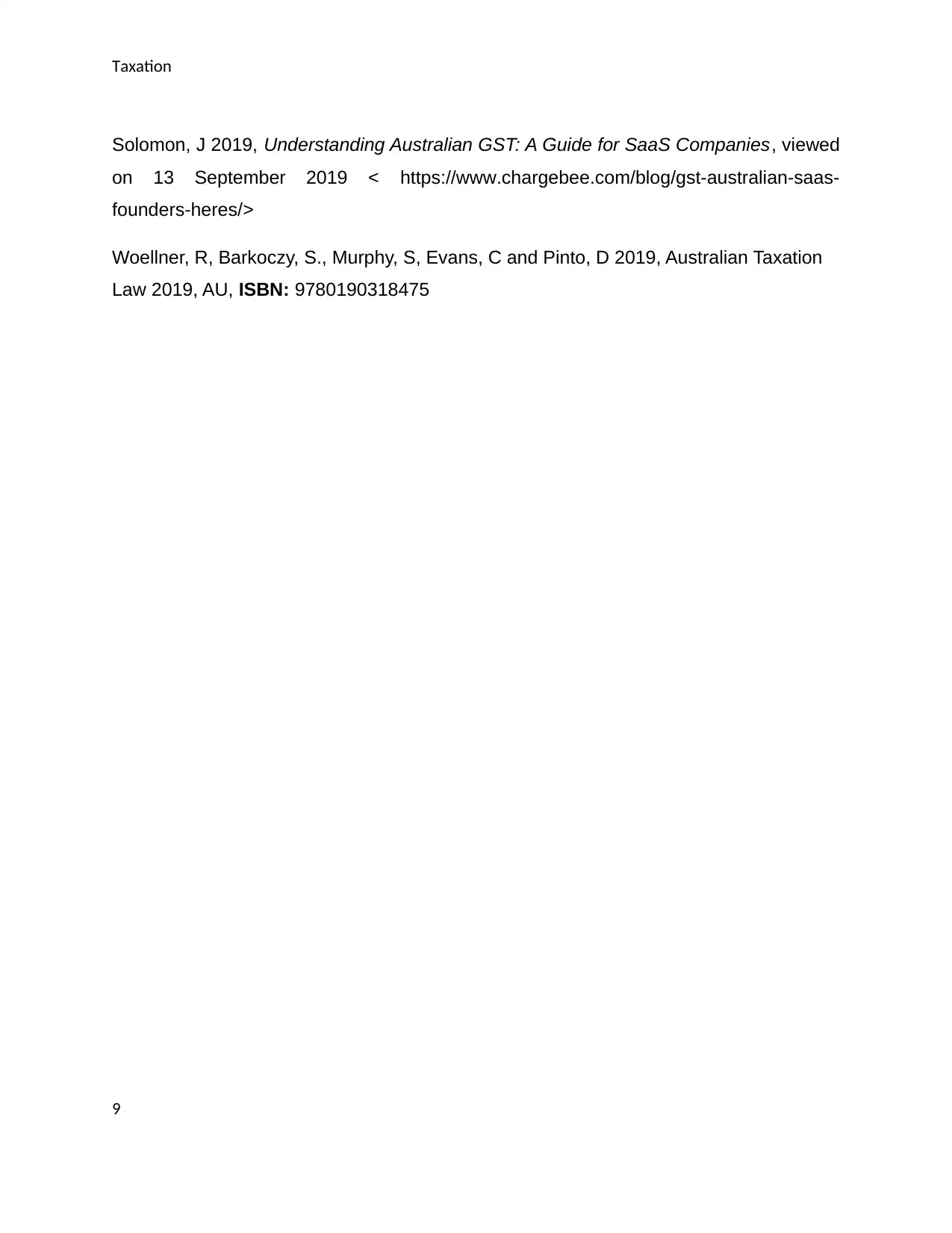
Taxation
Solomon, J 2019, Understanding Australian GST: A Guide for SaaS Companies, viewed
on 13 September 2019 < https://www.chargebee.com/blog/gst-australian-saas-
founders-heres/>
Woellner, R, Barkoczy, S., Murphy, S, Evans, C and Pinto, D 2019, Australian Taxation
Law 2019, AU, ISBN: 9780190318475
9
Solomon, J 2019, Understanding Australian GST: A Guide for SaaS Companies, viewed
on 13 September 2019 < https://www.chargebee.com/blog/gst-australian-saas-
founders-heres/>
Woellner, R, Barkoczy, S., Murphy, S, Evans, C and Pinto, D 2019, Australian Taxation
Law 2019, AU, ISBN: 9780190318475
9
1 out of 9
Related Documents
Your All-in-One AI-Powered Toolkit for Academic Success.
+13062052269
info@desklib.com
Available 24*7 on WhatsApp / Email
![[object Object]](/_next/static/media/star-bottom.7253800d.svg)
Unlock your academic potential
© 2024 | Zucol Services PVT LTD | All rights reserved.




